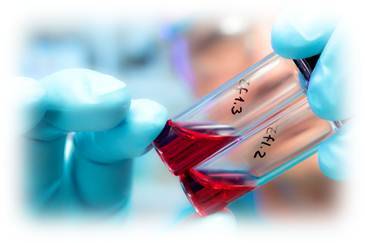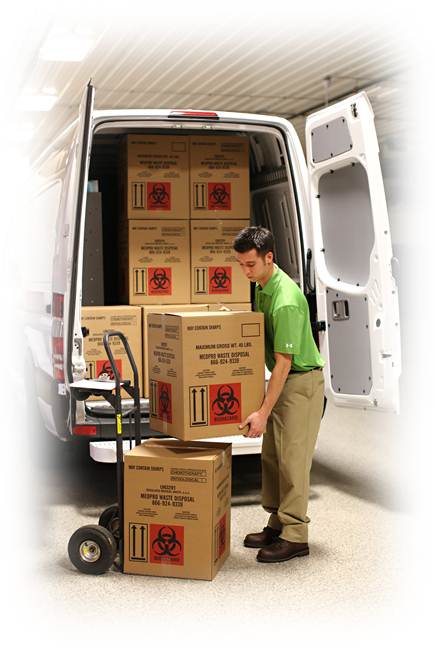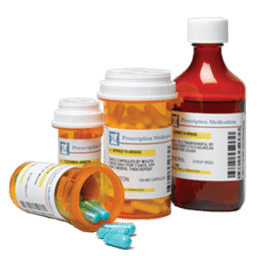According to the National Funeral Directors Association (article cited below) the best practices for funeral directors to keep the health and safety of the communities they live and work in are outlined below. If you have any questions contact MedPro Waste Disposal today 888-641-6131 or call your local health department.
“Funeral directors are trained to protect the health and safety of the public, the environment in the community in which they live and work, and their families and themselves. Best practices, like these recommended by NFDA, are designed to help our funeral directors meet the high standards of the funeral profession.
Be familiar with and follow each federal, state and local environmental requirement that applies when embalming is performed.
Periodically re-evaluate the products used in the preparation of the remains and throughout the funeral home. Review and be familiar with the Material Safety Data Sheets for the products used and make every effort to limit the toxicity of chemicals used and the amount of waste produced. Use only the amount of chemicals needed to assure proper embalming. Substitute environmentally friendly products as they become available. When possible, avoid the use of products containing phenol and cresol.
Assure that any system used for the disposal of embalming and sanitary fluids is properly sized, correctly operated and regularly maintained. Be aware of and immediately investigate and correct any problems discovered, using the services of trained licensed professionals for assistance. If the funeral home has expanded, assure that the capacity of the waste disposal system meets current needs. Make sure that the tank is periodically pumped, no less often than every three years.
Know the constituents of and the required method of disposal of any and all waste materials and fluids that the funeral home produces. Different requirements govern the handling and disposal of Hazardous Waste, Medical Waste, and other wastes produced in the course of funeral home operation. Be certain that any disposal firms with which you deal are licensed and reputable. Know where the wastes the funeral homes produces are taken for disposal and the compliance status of the disposal facility. Maintain copies of all waste disposal receipts. Each funeral director bears personal responsibility for the proper disposal of the wastes generated, as required by federal, state, and local law.
Cosmetics, adhesives, tissue builders, cleaning agents and other products that contain solvents or chlorinated compounds, such as trichloroethylene (“TCE”) and perchloroethylene (“Perc”), should only be used topically—if used at all. These compounds, including gauze or cotton containing such compounds and product residues in empty containers, should never be poured into a drain or sink, added to an embalming tank, tossed into a dumpster, commingled with other wastes, or discharged to the ground. Such wastes may be Hazardous Wastes requiring special handling.”
Guide To Managing Medical Waste Disposal
A Brief History of the Medical Waste Industry
Regulations covering medical waste disposal were formed in the 1980s in response to an alarming trend of infectious healthcare waste material from ending up in the regular solid waste stream.
Learn More: Medical Waste Tracking Act of 1988
With a federal mandate from the EPA now in place, everyone from hospitals to a single physician practice would have to adhere to strict laws about how to properly package and dispose of medical waste, which gave birth to the medical waste transportation and disposal industry.
Contaminated Gloves, Gauze, and Bandages:
What is it – Any time you use gloves with a client or patient, you need to take them off and dispose of them as soon as you leave the patient, even if you plan to return shortly. Used gauze or gauze that rests on anything that has not been sanitized must be disposed of. Bandages put out to be used with a patient and bandages that are taken off of a patient must be properly thrown away due to the potential for contamination.
How do you dispose of them – You can dispose of these items by placing them in a closable red Biohazard bag. Hospital-acquired infections are easily picked up in a hospital, nursing home or even in the office of a school nurse when gloves, gauze, and bandages are not properly disposed of.
Did you know – The US Centers for Disease Control and Prevention reported there were at least 1.7 million hospital-acquired infections in 2011 from pathogens that either caused or were the contributing factor in 99,000 deaths.
Find Out How Much You Can Save Instantly.
Try our on-line savings calculator.
Sharps:
What is it – Sharps are items that can cause cuts or puncture wounds such as needles, scalpels, glass ampoules, razor blades, sharp-pointed pieces of bones and teeth, stitch cutters, and other disposable sharp instruments.
How do you dispose of them – Loose sharps need to be enclosed in puncture-proof containers out of the way of patients. If placed in sturdy, puncture-proof, small enclosed Sharps containers, sharps may be disposed of in red Biohazard bags.
Did you know – According to the US Department of Labor’s Occupational and Safety Health Administration, injuries from blood borne pathogens on mishandled sharps pose a significant hazard for medical personnel. The FDA warns that loose sharps should never be thrown away in household or public trash containers, toilets or recycling bins.
Bodily Fluid & Blood Saturated Items:
What is it – Any material that is saturated with blood, saliva, semen and vaginal fluid, can contain viruses that may be passed to other people. Always error on the side of safety and assume that bodily fluid or blood soaked items are infectious. Clean up of bodily fluid and blood involves a mask, gloves, cleaning materials and bleach.
How do you dispose of them – All saturated items and everything used for cleanup must be disposed of in a red Biohazard container or bag.
Did you know – On carpeted areas which are highly absorbent, it’s important to respond quickly and select a cleaning product with some anti-microbial properties to help sanitize the area as thoroughly as possible. It’s also advisable to do a steam clean to remove debris, and sanitize carpeting more completely than conventional washing.
Chemotherapy Waste:
What is it – Chemotherapy is subject to a lot of waste, including expired drugs, dosages not used, contaminated masks, gloves and other personal protective equipment, partial containers of chemotherapy solution, and spillage cleanup materials. Chemotherapy is highly toxic and may cause irreversible damage if not managed and disposed of properly.
How do you dispose of them – Trace chemotherapy waste that does not appear to be contaminated (ex: tubing, needles, containers, gloves and gowns), or empty chemotherapy containers that did not hold P-listed chemotherapy agents, should be disposed of in Biohazard bags.
Bulk chemotherapy waste such as containers that contained P-listed chemo drugs, any non-empty containers of chemotherapy, or materials used to clean up a chemotherapy spill fall under RCRA hazardous waste regulations and must be disposed of as hazardous waste.
Did you know – In order for a container that has held a P-listed hazardous waste to be classified as “RCRA empty” and not regulated as hazardous waste, all the contents must be removed and it must be triple rinsed.
Medication:
What is it – Medications that are unused or are out of date present a unique disposal situation. They are not to be disposed of in a Biohazard bag.
How do you dispose of them – According to the FDA, almost all household medicines can be thrown in the household trash, but there are certain medications that are recommended to be disposed of immediately. This method is used by healthcare workers in hospice situations, but hospitals and pharmacies have special containers for these medications. They either contract with a medical waste company or participate in a mail-back program.
Did you know – To keep potentially dangerous medicines away from children or pets, the FDA recommends that unused medications be quickly turned over to a medicine take-back program or transferred to a collector who is authorized by the DEA.
Packaging the Waste
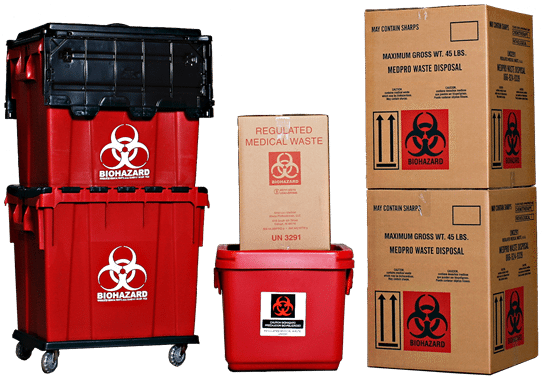
A physicians’ practice can generally expect a medical waste disposal company to provide containers like the ones above for medical waste storage and transportation. However, sharps must be placed in a closable, puncture-resistant, leak-proof container labeled as “biohazard.” Sharps containers (pictured right) will not typically be provided by your medical waste disposal company.
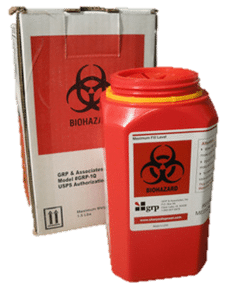
Other Types of Waste
Certain wastes are not considered medical waste and would not be accepted by a medical waste disposal company.
- Chemicals
- Hazardous Waste
- Radioactive Waste
- Bulk Chemotherapy Waste
- Compressed Gas Cylinders
- Inhalers and Aerosol Cans
- Glass Thermometers (or other devices containing mercury)
Expired or Unused Pharmaceutical Disposal
In October 2014 the DEA put the Disposal Act into effect which changes how long health care facilities have to store and dispose of pharmaceutical waste.
The three main changes are:
- The DEA relaxed the two-employee integrity requirement for inner liner installation, removal, storage, and transfer at LTCFs. Collectors will retain the option to authorize two of their own employees to install, remove, store, and transfer inner liners; however, the DEA is permitting collectors the option to designate a supervisor-level employee of the LTCF (e.g., a charge nurse, supervisor, or similar employee) to install, remove, store, or transfer inner liners with only one employee of the collector.
- After careful and thorough consideration of comments received regarding the burdens associated with the proposed 14-day destruction requirement, the DEA is extending the time those registrants that reverse distribute have to destroy controlled substances to 30 days.
- The DEA is also permitting registered hospitals/clinics with an on-site pharmacy to become authorized collectors to maintain collection receptacles inside their registered locations or at LTCFs, and to conduct mail-back programs.
All of these changes allow health care facilities to save time and money when disposing of medication.
Are you OSHA Compliant?
All employees who may come into contact with medical waste must be trained and certified on:
- OSHA Blood borne Pathogen Training
- Formaldehyde Exposure
- Infection Control
- Emergency Action Plans
- Hazard Communication Program:
- Safety Data Sheets
- Global Harmonization Standard Update
In addition, one of OSHA’s basic requirements is that every employer displays the Job Safety and Health Protection workplace poster (OSHA 2203 or state equivalent).

